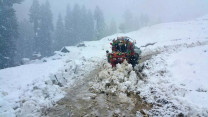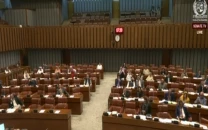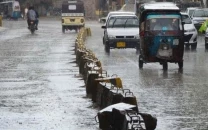Coping with the aftermath

Administration officials said that the out walls of eight houses had collapsed in the area. The Irrigation Department has been reconstructing the damaged embankment of Naullah Dek for the past two days. “The collapsed embankments could cause huge damage to nearby localities. We are trying our best to contain the situation,” said Irrigation Department official Mian Ameer.
A majority of villages in the area have already been evacuated by the district administration. “Emergency announcements are being made round the clock on loud speakers in local mosques, urging people to evacuate villages in the district,” said a local imam, adding that he was repeating emergency contact numbers via loudspeaker on an hourly basis to assist the flood victims.
Traffic remained suspended for several hours here, as all main roads and link roads between Pasrur and Daska and Pasrur and Sialkot were submerged under more than three feet of flood water.
Officials of the Sialkot district administration said that the relief operations were proving effective and the situation was under control. “No loss of life or damage to properties has been reported in the area as yet,” said tehsil municipal administration (TMA) official Mohammad Sial.
At least 13 villages and hundreds of acres of farmland in Bajwat-Sialkot were inundated due to flash floods in River Chenab near Head Marala on Friday evening.
Punjab Chief Minister Shahbaz Sharif said that all possible resources were being used for the rehabilitation of flood victims in southern Punjab. Speaking to reporters after visiting Chachran Sharif, the CM said that the Sasti Roti scheme would have to be shut down if a grant worth Rs10 billion was not released by the federal government to cope with the floods.
He said that torrential rains in southern Punjab were hampering helicopter services, adding that the flood victims would be rescued as soon as the weather conditions improved.
In Kot Addu, the floods have also created an electricity crisis due to the closure of 12 turbines of the Kot Addu Power Company (KAPCO) and two of the Lal Pir thermal plant.
There has been no electricity in the entire district for over five days.
In Muzaffargarh, water flow through the Taunsa barrage has receded to 643,000 cusecs. However, flood water still remains in the district.
The Pakistan Army, administration, Irrigation Department and police are trying to keep the flood waters away from important installations such as the Pak Arab Oil Refinery (PARCO), Pakistan State Oil (PSO) depot and Muzaffargarh Thermal Power station.
Officials at a flood control centre said that the administration’s efforts to breach Muzaffargarh canal to avert this threat have been resisted by people in nearby areas for fear of flood waters being re-directed their way.
Flood waters have now entered the Sinawan area and are headed towards Qasba Gujrat. Oil supplies from PARCO, which meet 47 per cent of domestic oil requirements, have been suspended due to the flood threat.
Published in The Express Tribune, August 8th, 2010.


1735037907-0/Tribune-N-(2)1735037907-0-208x130.webp)
















COMMENTS
Comments are moderated and generally will be posted if they are on-topic and not abusive.
For more information, please see our Comments FAQ